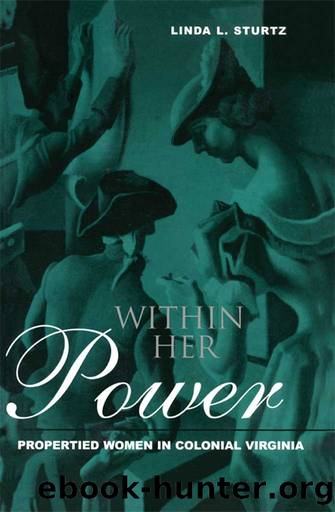Within Her Power by Linda Sturtz

Author:Linda Sturtz [Sturtz, Linda]
Language: eng
Format: epub
Tags: History, General, Social Science, Gender Studies
ISBN: 9781135302030
Google: 6eD9AQAAQBAJ
Publisher: Routledge
Published: 2013-11-05T16:00:10+00:00
FIGURE 6.2 Frances Nortonâs Dress. Silk Gown and Matching Petticoat. âBy tradition made in England in 1778 and brought to Virginia by Mrs. Frances Norton, daughter of Courtenay Norton.â125 Reproduced by permission of the Colonial Williamsburg Foundation. Accession G1946â133, 1953â171, 2.
The correspondence between customers and merchants demonstrates the commercial activities of married women who have eluded historians who dwelt excessively on legal status at the expense of understanding actual pursuits. Robert Cary and Company served Daniel Parke Custis and later his widow Martha (Dandridge) Custis (Washington),120 but a receipt of goods sent to Custis indicates that Mrs. Cary purchased some of the items.121 Elizabeth Perry made selections and offered advice to a Mrs. Jones on clothing. Perry explained that she bought a more fashionable âParkey Burdetâ instead of the originally requested fabric because she â[th] ought a chery dery had too mean a look,â or too down-market an image for her Virginia customer. The substitution was more expensive than the original order. Perry was also unable to find the requested âspriggâd muslin... there is no such thing.â122 Perryâs letter is interesting in that it is directly between the female purchaser and female buyer at a time when much of the correspondence regarding purchases was made through male family members.
Virginia-born English resident Courtenay Norton served as a purchaser of goods for her familyâs firm, John Norton and Sons. One Virginia woman, when ordering china through the Nortons in 1771, requested specifically that Mrs. Norton choose the dishes.123 This is significant because during the Revolutionary War era ceramic increasingly replaced pewter for drinking vessels. Ceramic teacups became an increasingly common consumer item even for âmiddlingâ level colonists, and fashions and technologies were subject to rapid changes. A range of merchandise, from cheap to expensive (some cups and saucers cost the equivalent of a weekâs wages of a laborer), was offered to Virginia customers. Even less prosperous Virginians sought to âlive in the vogue of the cosmopolitan center of the British empireâ by acquiring and using newly available creamware and patterned ceramics.124 In this context of specialized consumer demand for the latest fashions of goods that displayed a familyâs social ranking and economic position, a customer could turn to Mrs. Nortonâs taste in goods available in England. (For some indication of the Norton womenâs choice in fashion items, see fig. 6.2). The family business benefited from her specialized function within the firm.
Mrs. Norton also acquired supplies at the wholesale level when Charlotte Dickson set up a Williamsburg store with her son Beverley. Then, the Dicksons ordered their goods from the firm of John Norton and Sons and, in thanking the Nortons for supplying them with merchandise that sold quickly, Beverley wrote that they were âobligâdâ to Mrs Norton âfor choosing her things so well.â126
Mrs. Norton occasionally ran into communications difficulties because of the distance between the London and Yorktown bases of operation. After the Dicksons set up their Williamsburg shop they asked Mrs. Norton to get a pair of stays made to the same measurements as those on file with an English supplier.
Download
This site does not store any files on its server. We only index and link to content provided by other sites. Please contact the content providers to delete copyright contents if any and email us, we'll remove relevant links or contents immediately.
| Africa | Americas |
| Arctic & Antarctica | Asia |
| Australia & Oceania | Europe |
| Middle East | Russia |
| United States | World |
| Ancient Civilizations | Military |
| Historical Study & Educational Resources |
Never by Ken Follett(2884)
The Man Who Died Twice by Richard Osman(2300)
Machine Learning at Scale with H2O by Gregory Keys | David Whiting(2293)
Fairy Tale by Stephen King(2072)
Will by Will Smith(2043)
Rationality by Steven Pinker(1765)
The Dawn of Everything: A New History of Humanity by David Graeber & David Wengrow(1571)
The Dark Hours by Michael Connelly(1571)
Principles for Dealing With the Changing World Order: Why Nations Succeed and Fail by Ray Dalio(1378)
Friends, Lovers, and the Big Terrible Thing by Matthew Perry(1330)
A Short History of War by Jeremy Black(1300)
HBR's 10 Must Reads 2022 by Harvard Business Review(1256)
Go Tell the Bees That I Am Gone by Diana Gabaldon(1236)
Can't Hurt Me: Master Your Mind and Defy the Odds - Clean Edition by David Goggins(1228)
515945210 by Unknown(1209)
Fear No Evil by James Patterson(1110)
443319537 by Unknown(1074)
Works by Richard Wright(1020)
Going There by Katie Couric(993)
